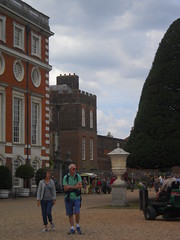I thought I would start reviewing castles and palaces I visited in Europe, starting with the four I used for my thesis, in the hopes that I would remember to post here more regularly. We’ll begin with Hampton Court Palace.

I loved visiting Hampton Court Palace outside London. Hampton Court is actually two palaces in one: a Tudor section built by Cardinal Thomas Wolsey on a site previously owned by the Knights Templar; and the baroque section built during the reigns of William and Mary and Queen Anne. The Cardinal was forced to turn the sumptuous palace over to Henry VIII, who was unhappy with the Cardinal’s inability to get the king’s divorce from Katherine of Aragon. Henry and Anne Boleyn continued upgrades until her arrest and beheading; each subsequent wife is also associated with the palace and spent time there. Henry’s three heirs, each a ruler themselves, also spent time at the palace – as did the Stuart kings and Oliver Cromwell.

After gaining the throne, William and Mary engaged Sir Christopher Wren as architect to rebuild the palace in a more continental style. Queen Anne continued with redecorating upon her ascension; fortunately for us, there were insufficient funds to rebuild the entire palace, leaving us a unique palace of Tudor and Hanoverian sections.
The first two Georges also used the palace. However, due to bad memories, George III refused to live there and turned the palace into grace-and-favour apartments for those who had provided great service to crown or country – the last of whom stopped living there in the 1980s. It was opened to public visitors by Queen Victoria in the late 1830s, early 1840s.
I enjoyed the gardens (open during the summer) and the William and Mary sections, but my favorite was the Tudor section. Perhaps it was the costumed Tudor interpreters (I later saw the Georgian interpreters a year or so after my initial visit, for the 300th anniversary of their ascension). But the Tudor sections seemed the most livable and warm, with the woods and rich tapestries. The William and Mary and Georgian sections were for the public display of the monarch, with very few rooms for the private monarch to be themselves. The Tudor section also has the rooms to allow court to function (kitchens, the royal chapel, pages’ room, the Great Hall, etc.), helping to present a picture beyond the glamour and privilege of the royals. My preference is probably also due partly to the fact that I really enjoy Tudor history.
Check it out for yourself at: http://www.hrp.org.uk/hampton-court-palace/ .
